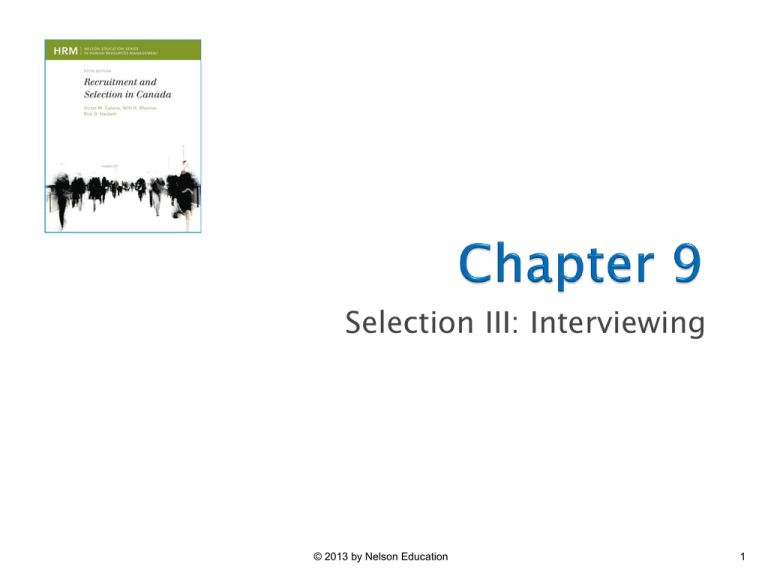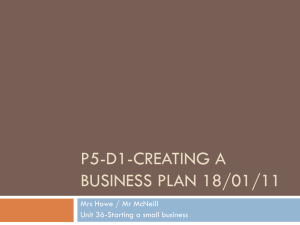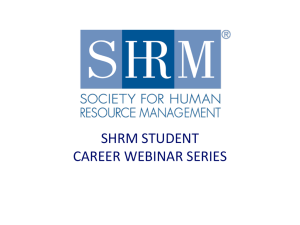Chapter 9
advertisement

Selection III: Interviewing © 2013 by Nelson Education 1 Chapter Learning Outcomes After reading this chapter you should: ◦ Understand the purposes and uses of employment interviews ◦ Know the multiple phases of the employment interview and the factors affecting employment interview decisions ◦ Appreciate the selection errors associated with traditional approaches to employment interviewing © 2013 by Nelson Education 2 Chapter Learning Outcomes (continued) ◦ Understand the elements of employment interview structuring ◦ Be aware of different structured interviewing techniques and their relative advantages and disadvantages ◦ Appreciate the legal and predictive advantages of structured employment interviewing methods © 2013 by Nelson Education 3 Chapter Learning Outcomes (continued) ◦ Begin developing competence in the design of effective interview questions and scoring guides ◦ Know about innovations and future directions in interview research and practice ◦ Appreciate the role of employment interviews in the changing organizational environment © 2013 by Nelson Education 4 Purposes and Uses of the Interview Interviews: used at the beginning or end of the selection process Used to explore and expand information from the resume/application form Employs standard questions during the interview process Panel interviews include the HR professional Used to sell the job to the applicant © 2013 by Nelson Education 5 Purposes and Uses of the Interview (continued) Best suited to the assessment of noncognitive attributes Provides the applicant a chance to ask questions about the job and organization Provides an opportunity to see if there is a suitable fit Used in the termination of employees Used to determine who is best qualified © 2013 by Nelson Education 6 The Cost of Interviewing Time preparing for the interview (Supervisor/Managers) Actual interviewing time Time spent by clerical staff on interviewrelated tasks © 2013 by Nelson Education 7 The Cost of Interviewing (continued) Use of office space and equipment Time spent developing interview questions and scoring guides Travel time © 2013 by Nelson Education 8 Typical Screening Interview Screening interviews: preliminary interviews designed to fill gaps left on the candidate’s application form or resume; sometimes serving recruitment as well as selection functions © 2013 by Nelson Education 9 Screening Interview Format Follow a set of pre-planned questions during the interview Review the applicant’s file before the interview Begin with some opening remarks by recruiter to put the applicant at ease © 2013 by Nelson Education 10 Screening Interview Format (continued) Design questions to focus on applicant’s previous work experience, educational background Closing: gives applicant an opportunity to ask questions about the job and the organization ◦ Recruiter discusses timeframe of when they are getting back to applicant Review the applicant with a rating form © 2013 by Nelson Education 11 Recruitment and Selection Today 9.3 Interviewee Behaviours That Influence Positive Interviewer Impressions ◦ Be on time for the interview ◦ Be prepared for the interview by having done homework on the company Make direct eye contact with the interviewer ◦ Remain confident and determined throughout the interview, regardless of how the interviewer’s cues suggest the interview is going © 2013 by Nelson Education 12 Recruitment and Selection Today 9.3 (continued) ◦ Provide positive information about oneself when answering questions ◦ Answer questions quickly and intelligently ◦ Demonstrate interest in the position and organization © 2013 by Nelson Education 13 Recruitment and Selection Today 9.3 (continued) Interviewee Behaviours That Influence Negative Interviewer Impressions ◦ ◦ ◦ ◦ ◦ ◦ ◦ Present a poor personal appearance or grooming Display an overly aggressive, know-it-all attitude Fail to communicate clearly Lack career goals or career planning Overemphasize monetary issues Be evasive Show a lack of maturity, tact, and courtesy © 2013 by Nelson Education 14 Speed Interviewing Speed interviewing: typically consists of a series of short (5-15 minute) consecutive interviews ◦ Used by recruiters who need to fill several positions quickly and cost effective ◦ Ascertains a candidate’s fit with position requirements © 2013 by Nelson Education 15 © 2013 by Nelson Education 16 A Model of Information Processing/Decision Making Prior Information and Interviewer and Candidate Expectations Knowledge Structures The Social Interaction of Interviewer and Candidate © 2013 by Nelson Education 17 A Model of Information Processing/Decision Making (continued) Interviewer and Candidate Information Processing and Assessments Interviewer and Applicant Decisions The Context of the Interview © 2013 by Nelson Education 18 Unstructured Interviews Unstructured interview: a traditional method of interviewing that involves no constraints on the questions asked ◦ No requirements for standardization ◦ A subjective assessment of the candidate (feeling or hunch about the candidate) © 2013 by Nelson Education 19 Recruitment and Selection Today 9.4 Commonly Used Interview Questions 1. Why did you leave your last job? Why do you want to leave your current job? 2. What do you consider to be your strengths? What are your weaknesses? 3. What were your strongest/weakest subjects at school? What did you learn in school that you could use in this job? © 2013 by Nelson Education 20 Recruitment and Selection Today 9.4 (continued) 4. How would other people (or someone who knows you or worked with you) describe you as an individual? 5. What is your greatest accomplishment (or most meaningful work experience)? 6. What were the most enjoyable aspects of your last job? What were the least enjoyable aspects? © 2013 by Nelson Education 21 Recruitment and Selection Today 9.4 (continued) 7. Why do you want this job? What are you looking for from this job (or from us)? 8. Why should we hire you? What can you do for us? 9. What are your long-range plans or goals? 10. Tell me about yourself. © 2013 by Nelson Education 22 Structured Interview Structured interview: consists of a standardized set of job-relevant questions; a scoring guide is used ◦ Remains popular with employers © 2013 by Nelson Education 23 Structured Employment Interviews Interview questions are derived from a job analysis Interview questions are standardized (all applicants are asked the same questions) Prompting, follow-up questioning, probing and/or elaboration on questions are limited © 2013 by Nelson Education 24 Structured Employment Interviews (continued) Interview questions focus on behaviours or work samples rather than opinions or selfevaluations Interviewer access to ancillary information Questions from the candidate are not allowed until after the interview Each answer is rated during the interview using a rating scale tailored to the question © 2013 by Nelson Education 25 Structured Employment Interviews (continued) Rating scales are “anchored” with behavioural examples to illustrate scale points Total interview score is obtained by summing across scores for each of the questions Detailed notes are taken during the interview © 2013 by Nelson Education 26 Recruitment and Selection Notebook 9.3 The Structured Interviewing Process ◦ Preparing for the interview: 1.Determine the amount of time available and how many questions you can ask without rushing 2.Make a standardized list of interview questions to ask all applicants in the same order 3.Develop a scoring guide with benchmark or sample answers 4.Use a space where you can have privacy, freedom from distractions, and quiet © 2013 by Nelson Education 27 Recruitment and Selection Notebook 9.3 (continued) 4. Schedule the interviews with sufficient time for a brief break between interviews and to allow for some interviews to run a little over 5. Arrange to hold all calls and prevent interruptions during the interview © 2013 by Nelson Education 28 Recruitment and Selection Notebook 9.3 (continued) ◦ Conducting the interview: 1. Spend a few minutes at the beginning of the interview putting the applicant at ease 2. Ask each question in turn without omitting or skipping any 3. Take detailed notes, focusing on recording what the applicant says 4. Allow the applicant to ask questions at the end of the interview and answer them to the best of your ability 5. Follow the same procedures for each applicant and retain interview documentation for future reference © 2013 by Nelson Education 29 Recruitment and Selection Notebook 9.3 (continued) ◦ Closing the interview: 1. Tell the candidate when and how he should expect to hear from you 2. Tell the candidate if you will be contacting references or conducting a second interview 3. Thank the applicant for coming 4. Review your notes and make your ratings 5. Make sure you inform all candidates of your decision when you have made it © 2013 by Nelson Education 30 Class Activity 1. 2. Have you experienced structured and/or unstructured interviews? How did you feel about the process? © 2013 by Nelson Education 31 Panel and Serial Interviews Panel interview: an interview conducted by two or more interviewers together at one time Serial interviews: a series of interviews where the applicant is interviewed separately by each of two or more interviewers © 2013 by Nelson Education 32 Situational Interview Situational interview: a highly structured interview in which important or decisive situations employees are likely to encounter on the job are described ◦ Applicants are asked what they would do in these situations © 2013 by Nelson Education 33 Scoring Guide Scoring guide: a behavioural rating scale consisting of sample answers to each question that is used by the interviewer to evaluate and score the applicant’s answers © 2013 by Nelson Education 34 Behaviour Description Interview Behaviour description interview: a structured interview in which the applicant is asked to describe what he did in given situation in the past Probes: follow-up questions or prompts used by the interviewer to guide the applicant’s descriptions of situations to provide scorable elaboration of answers © 2013 by Nelson Education 35 Other Approaches to Interviewing Long-distance Interviews Puzzle Interviews Multi-mini Interviews © 2013 by Nelson Education 36 Summary Employment interviews are the most popular selection procedure Use behavioural interviews Ask interviewing questions that tie directly to the job © 2013 by Nelson Education 37 Discussion Questions 1. 2. What factors affect employment interview decisions? What are the different errors or biases that commonly occur as part of a traditional employment interview? © 2013 by Nelson Education 38 Discussion Questions (continued) 3. 4. Why is a scoring guide crucial to the success of a structured interview? Why do many employers resist using structured interviews? How would you encourage more employers to use structured interview techniques? © 2013 by Nelson Education 39








